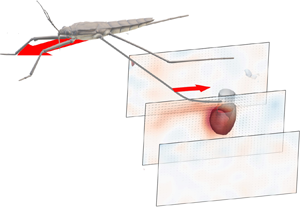Published online by Cambridge University Press: 29 March 2021

Our understanding of animal locomotion in air and water has progressed considerably, based on studies of their wakes. Wake vortices are the hallmarks of momentum transfer and enable an inverse inference of the forces applied by animals. Such approach has recently been extended to locomotion at the air–water interface, focusing on the familiar water striders and their dual hallmarks, surface capillary waves and bulk water vortices, produced by their paddling legs. However, the principal mechanisms of propulsion used in this type of locomotion remain a matter of debate. We confirm that the main force driving propulsion is the capillary force resulting from surface tension, and that interface relaxation makes a major contribution to the increase in vorticity of the water bulk. There is therefore no one-to-one mapping between forces and hallmarks in the fluid. Locomotion at the air–water interface for animals with virtual oars much larger than the size of their legs thus requires specific treatment outside the existing framework based on immersed propulsive appendices.